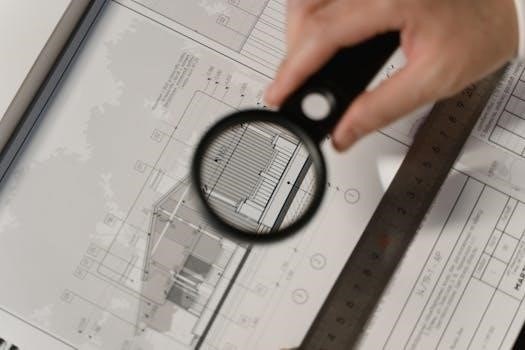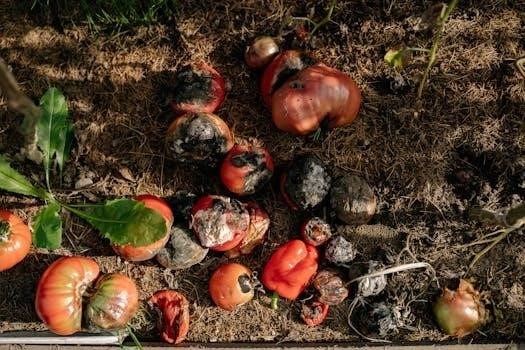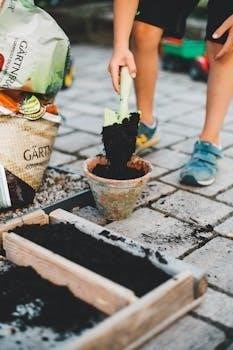DIY Compost Bin Plans Overview
With numerous homemade DIY compost bin plans available, finding a design to suit your needs is easy. This guide provides step-by-step instructions to help you build a functional compost bin from scratch.
Free PDF Download Availability
Many online resources offer free PDF downloads of compost bin plans, making it easy to access detailed instructions and materials lists. These downloadable files typically include illustrated details, cutting lists, and shopping lists, simplifying the construction process. The availability of free PDF plans allows both beginners and experienced DIY enthusiasts to start building their compost bins without any upfront costs. By utilizing these free resources, you can efficiently create a compost bin that suits your specific needs and space requirements, promoting sustainable practices and reducing waste. Look for links at the bottom of blog posts or on dedicated DIY websites to access these valuable resources for your composting project.
Variety of DIY Compost Bin Designs
The world of DIY compost bins offers a diverse range of designs, catering to various needs and skill levels. From simple single-bin structures to more complex multi-bay systems, there’s a design for every garden and composting requirement. Options include pallet compost bins, which are easy to assemble and cost-effective, as well as concrete block bins that offer durability. Whether you prefer a basic bin for turning compost or a more elaborate system for aging it, numerous free plans are available, allowing you to customize your setup to fit your space and preferences. Explore different designs to find the perfect compost bin solution for your home.
Beginner-Friendly Construction
Many DIY compost bin plans are designed with beginners in mind, ensuring that even those with limited construction experience can successfully build a functional compost bin. These plans often feature straightforward instructions, clear diagrams, and readily available materials. Simpler designs, like those using pallets, require minimal cutting and assembly, making them ideal for first-time DIYers. The focus is on creating a compost bin that is both effective and easy to build. With free plans and tutorials, anyone can embark on this eco-friendly project and start composting at home. This allows for a smooth introduction to the world of DIY building.

Materials and Construction
DIY compost bins can be built using various materials like pallets and concrete blocks. These materials offer different construction methods, each with its own advantages for building a compost bin.
Pallet Compost Bin Plans
Pallet compost bin plans are a popular choice due to their simplicity and the use of readily available, often free, materials. These plans typically involve assembling wooden pallets to create a sturdy enclosure for composting. The open design of pallets allows for good airflow, essential for proper decomposition. Many free plans are available online, often including step-by-step instructions and diagrams. Pallet bins are easy to modify and can be customized to fit specific garden sizes. They offer a cost-effective and eco-friendly way to start composting. The process is beginner-friendly, making it a great option for those new to DIY projects and composting.
Concrete Block Compost Bin Plans
Concrete block compost bin plans offer a robust and durable option for those seeking a long-lasting composting solution. These plans typically involve stacking concrete blocks to form a sturdy enclosure. The weight of the blocks provides stability, and the modular nature allows for easy expansion. Many plans are straightforward, requiring minimal construction skills. Concrete blocks are readily available and relatively inexpensive, making this an accessible option. While slightly less mobile than pallet bins, they offer excellent durability and can withstand various weather conditions. This design is well-suited for larger gardens or high-volume composting needs.
Sturdy and Durable Designs
Many DIY compost bin plans focus on creating sturdy and durable structures, ensuring that your compost bin will withstand the test of time and the elements. These designs often incorporate robust materials like treated lumber, concrete blocks, or heavy-duty pallets, providing a solid foundation. The construction methods are typically straightforward, emphasizing secure joints and reinforced corners to prevent collapse or warping. A well-built compost bin can handle significant weight and resist damage from weather and pests. These durable designs are ideal for those who want a long-term composting solution without constant repairs or replacements, offering peace of mind and years of reliable service.

Features and Functionality
Compost bin designs often include features like good airflow and critter-proof latches. These elements ensure efficient decomposition and keep unwanted animals out, leading to a successful composting process.
Good Airflow Design
Proper airflow is crucial for successful composting, and many DIY compost bin plans prioritize this aspect. Designs often incorporate features like gaps between slats in pallet bins or ventilation holes in concrete block structures. This promotes aerobic decomposition, which is essential for breaking down organic matter efficiently and preventing foul odors. Adequate ventilation also helps regulate moisture levels within the compost bin, preventing it from becoming too wet or too dry. The free flow of oxygen is vital for the microorganisms responsible for the composting process, ensuring the production of nutrient-rich compost ready for your garden. Look for plans that specifically address ventilation to maximize the effectiveness of your compost bin.
Critter-Proof Latching Mechanisms
To ensure your compost bin remains secure and free from unwanted visitors, many DIY designs include critter-proof latching mechanisms. These mechanisms are essential for keeping out pests such as rodents, raccoons, and other animals that may be attracted to the organic waste inside. Secure latches can be implemented in various ways, from simple hook-and-eye closures to more elaborate bolt systems. The goal is to create a tight seal that prevents animals from accessing the compost, ensuring that the composting process is not disrupted and the valuable compost remains protected. Look for plans that emphasize robust and reliable latching solutions for a hassle-free composting experience;

Benefits of Using Compost Bins
Compost bins are crucial for waste reduction, diverting organic materials from landfills. They also enrich garden soil, providing essential nutrients for healthy plant growth and sustainable gardening.
Waste Reduction and Recycling
Utilizing compost bins significantly contributes to waste reduction by diverting kitchen scraps and yard waste from landfills. This process not only minimizes the volume of trash sent for disposal but also reduces the environmental impact associated with landfill operations. Recycling organic matter through composting turns waste into a valuable resource, promoting a circular economy. This eco-friendly practice helps decrease methane emissions from decomposing waste in landfills. Furthermore, it reduces the need for synthetic fertilizers, which are often produced using energy-intensive processes. Composting, therefore, is an essential step towards a more sustainable and environmentally responsible lifestyle, effectively transforming waste into a beneficial product for gardening.
Enriching Garden Soil
Composting enriches garden soil by creating a nutrient-rich amendment that improves soil structure and fertility. Compost provides essential elements like nitrogen, phosphorus, and potassium, which are crucial for healthy plant growth. The addition of compost to soil enhances its water retention capacity, reducing the need for frequent watering. It also improves aeration, allowing plant roots to breathe and thrive. Compost introduces beneficial microorganisms that contribute to a healthy soil ecosystem, breaking down organic matter and making nutrients readily available to plants. This natural soil conditioner reduces reliance on chemical fertilizers, promoting a healthier garden environment and better crop yields.

Additional Resources
Find step-by-step instructions, cutting lists, and shopping lists to aid in your compost bin construction. These resources will help you build your own compost bin.
Step-by-Step Instructions
Our detailed step-by-step instructions make building a compost bin straightforward for everyone, from beginners to advanced woodworkers. These plans guide you through each stage of construction, ensuring a successful project. You’ll find clear directions on assembling the frame, attaching panels, and adding any additional features, such as a critter-proof latch. The instructions are designed to be easy to follow, using simple language and clear illustrations, and are tailored for various skill levels. Whether you’re using pallets, concrete blocks, or other materials, these comprehensive instructions will help you create a sturdy and functional compost bin. Download the accompanying PDF for visual aids and detailed diagrams that will further simplify the process. With our step-by-step guidance, you can confidently build a compost bin that suits your garden needs.
Cutting and Shopping Lists
To streamline your compost bin construction, we provide comprehensive cutting and shopping lists. These lists ensure you have all the necessary materials before beginning your project, saving you time and hassle. The cutting lists specify the exact dimensions of each piece of wood, concrete block, or other material you will need, minimizing waste and errors. The shopping lists itemize all the necessary hardware, such as screws, nails, latches, and hinges, ensuring you don’t miss any critical components. These detailed lists are included in the downloadable PDF, making it convenient to gather your supplies. With our organized cutting and shopping lists, you can efficiently prepare for your build and focus on the enjoyment of creating your own compost bin. These lists are tailored for each design, ensuring accuracy and ease.